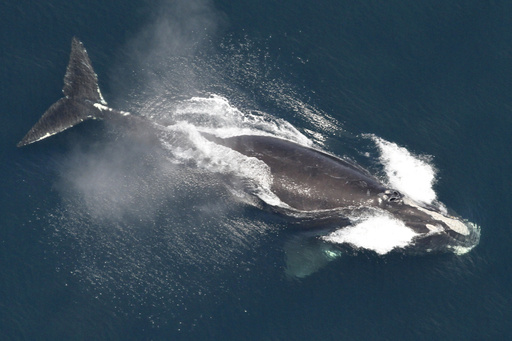
BOOTHBAY HARBOR, Maine — The population of one of the world’s most endangered whale species, the North Atlantic right whale, has seen a slight increase, prompting conservationists to urge the federal government and the shipping and fishing industries to intensify efforts to prevent these majestic creatures from facing extinction.
The North Atlantic right whale, which can weigh as much as 150,000 pounds (68,039 kilograms) and inhabits the waters off the East Coast, experienced a dramatic decline during the 2010s. By the early 2020s, the critically endangered species had dwindled to fewer than 360 individuals, primarily threatened by global warming and the risks of ship collisions and entanglement in fishing gear.
Recent figures released by a team of researchers indicate that the whale population has risen to an estimated 372 in 2023, marking an approximate 4% increase from 2020. This news is regarded as encouraging following a substantial decline of nearly 25% in the population from 2010 to 2020, according to the researchers’ statement.
The researchers belong to the North Atlantic Right Whale Consortium, a collaborative effort that includes scientists, conservationists, and members of the marine industry. Heather Pettis, a research scientist at the New England Aquarium’s Anderson Cabot Center and chair of the consortium, emphasized the need for continued commitment from both conservationists and government regulators to further support the species’ recovery.
“It’s a particularly vulnerable population. A single poor calving year can substantially affect the total number,” Pettis remarked. “We must ensure the whales can successfully calve, breed, and feed without the various stress factors.”
Though recent birth trends seem to indicate improvements compared to the 2010s, the number of new calves remains below the figures seen in the 2000s, and ongoing threats pose serious concerns. As of this year, there have been five reported deaths of right whales along with four other calves that went missing, marking the highest annual mortality count since 2019. These nine fatalities may potentially lead to a decrease in the population by 2024, the consortium noted.
Many of this year’s recorded right whale deaths showed signs of chronic entanglement and incidences of vessel strikes, highlighting the urgent need for the government to implement new regulations targeting fishing and shipping practices, as emphasized by conservation groups.
“While the uptick in population is encouraging, the fatalities of North Atlantic right whales washing ashore are stark reminders that we must take decisive action to stop their deaths,” stated Gib Brogan, campaign director at Oceana.
Efforts to implement protective measures for the whales have faced challenges. In February, a coalition of environmental groups filed a lawsuit against the National Oceanic and Atmospheric Administration to compel the agency to finalize proposed ship speed regulations introduced in 2022, aimed at shielding the whales from vessel strikes. Moreover, proposed regulations by the National Marine Fisheries Service to reduce the risk of entanglement have encountered opposition from fishing industry representatives.
Each year, the whales migrate from their calving grounds located off Florida and Georgia to feeding areas in New England and Canada. However, the journey has become increasingly perilous due to rising ocean temperatures, forcing the whales to venture outside previously established protected zones in search of essential small marine organisms, according to scientists.
By the late 1890s, hunting had nearly eradicated the whales, and despite being federally protected for several decades now, their population has yet to recover to levels prior to the whaling era.
